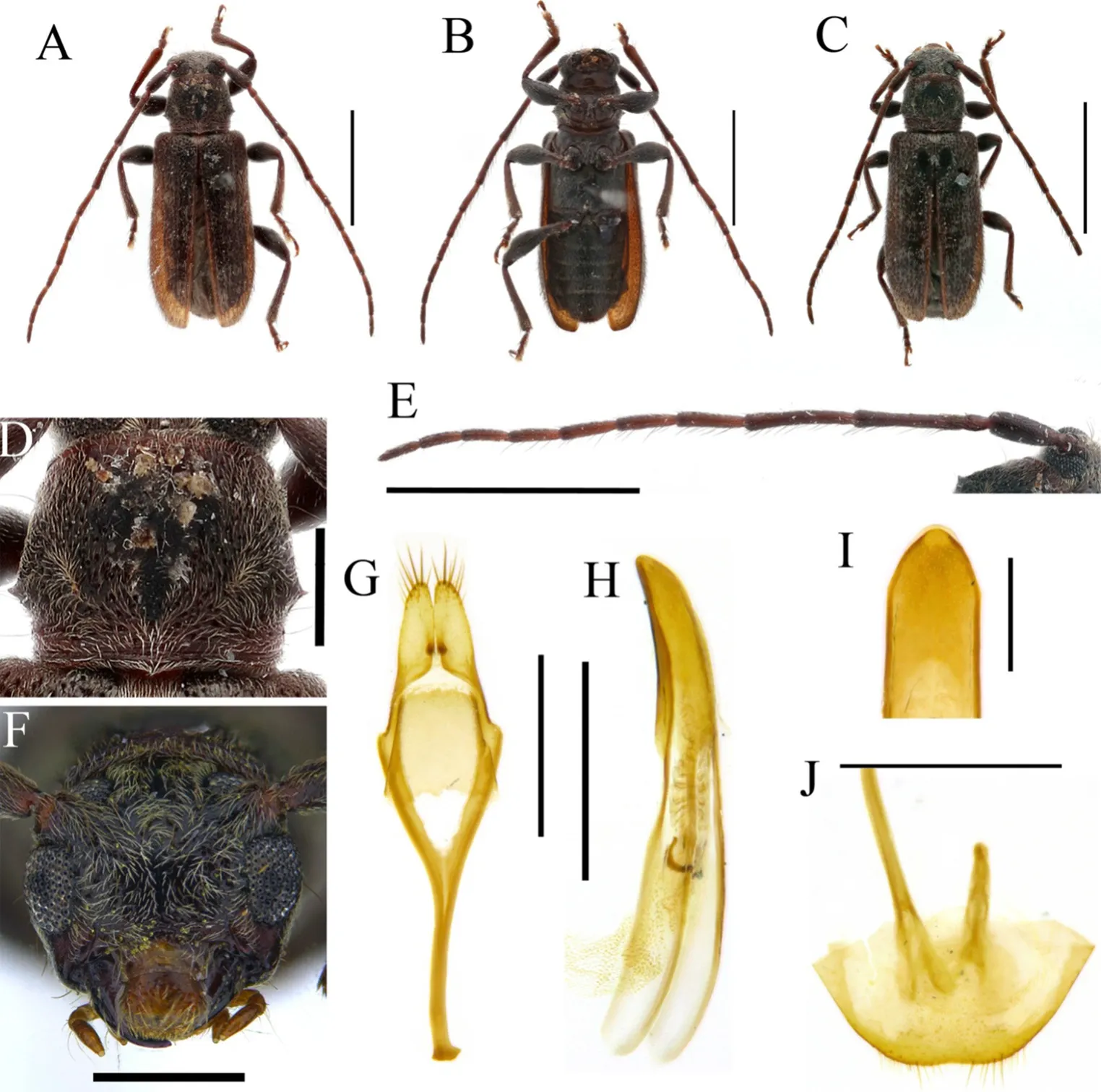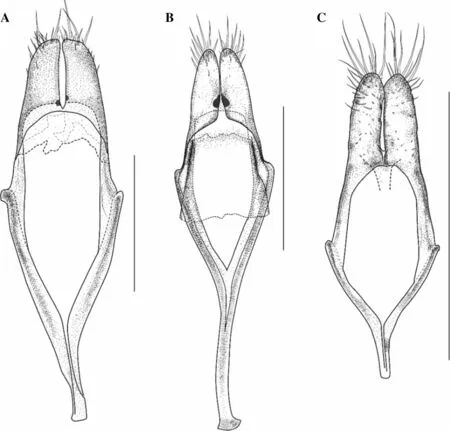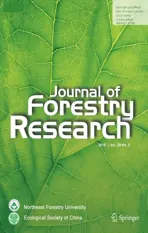A taxonomic review of the genus Miaenia Pascoe,1864(Coleoptera:Cerambycidae)from South Korea with a new record of M.tonsa(Bates)
2018-05-19IkJeChoiTaeSungKwonJongokLim
Ik Je Choi•Tae Sung Kwon•Jongok Lim
Introduction
The Cerambycidae is one of the largest families belonging to Cerambycoidea(Insecta:Coleoptera)with an estimated 35,000 species worldwide(Lawrence 1982),and 357 species belonging to six subfamilies have been recorded in the Korean peninsula(Paek et al.2010;Lim et al.2012;Jang et al.2015;Jeon et al.2015).
The genusMiaeniabelongs to the tribe Acanthocinini Pascoe that was established based onMiaenia marmorea.Recently,Roguet(2013)synonymizedSciadeswithMiaeniabecause the genus name,Sciades,was already a preoccupied homonym of a fish genus,SciadesMu¨ller&Troschel,1849(Vertebrata:Ariidae).
Presently the genusMiaeniais composed of 13 subgenera and 89 species worldwide,and two species,Miaenia fasciata fasciata(Matsushita)andMiaenia maritimaTsherepanov have been reported on the Korean peninsula but without comprehensive taxonomic information.
In this paper we review the KoreanMiaeniaspecies and introduceM.tonsa(Bates)as a new record to the Korean fauna.A key to the KoreanMiaeniaspecies,photographs and illustrations of diagnostic characteristics,including male genitalia for each species,are provided.
Materials and methods
For the identi fication of species,we compared the Korean specimens with Japanese specimens ofM.fasciata fasciataandM.tonsadonated by Dr.Junsuke Yamasako(Tokyo University,Japan).
The abbreviations for morphological characteristics and provinces of collection locality in South Korea are as follow:GN,Gyeongsangnam-do;BS,Busan-si;JJ,Jeju-do;BL,maximum length of body from median clypeus to elytra at apex in dorsal view;PL,maximum length of pronotum measured along median line in dorsal view;PW,maximum width of pronotum at its widest point in dorsal view(postero-lateral tubercles excluded);EL,length of elytron from base to apex along median line in dorsal view;EW,maximum width of elytra in dorsal view.The terms on external morphology and male genitalia follow Lingafelter and Hoebeke (2002) and Ehara (1954),respectively.
For illustrations of diagnostic characteristics,we used a Leica Microsystems M 205A Stereozoom(Leica,Solms,Germany)connected with a digitalcamera,Leica Microsystems DE/DFC 49.The images were then manipulated with LAS(version 4.1.0.,Leica Microsystems,Switzerland).
The materials used in this study are deposited at the Insect Collection of the Korea National Arboretum,Korea Forest Service,Pocheon-si,South Korea.
Results
Genus Miaenia Pascoe,1864(Korean name:Jeong-Ha-Neul-So-Sok)
MiaeniaPascoe,1864:27.Type species:Miaenia marmoreaPascoe,1864
SciadesPascoe,1864:30.Typespecies:Leiopus suffususPascoe,1864
Diagnosis:The genus can be distinguished from other genera in the subfamily Acanthocinini by a combination of the following characteristics:body with dense pubescence(Fig.1A);head retractable(Fig.1F);antennae more or less fine,longer than body,sparsely fringed with short pubescence;antennomere I long and thin,shorter than antennomere III,longer than antennomere V(Fig.1E);lateral margin of pronotum with small tubercle behind the middle(Fig.1D);elytra longer or shorter,convex,slightly wider than pronotum,almost rounded apex;prosternal protrusion with right angle and arched;metasternum normal length;intermediate coxal cavities closed;femora clavate.
Subgenus Estoliops Matsushita,1943
EstoliopsMatsushita,1943:574.Type species:Estoliops fasciataMatsushita,1943
Remarks:The two subgenera,EstoliopsandMiaenia,share similar external morphological characteristics.However,Estoliopscan be de fined by strong postero-lateral projections on the pronotum(very weak projection inMiaenia)and antennomere III distinctly longer than antennomere IV(more than 10%)(antennomere III nearly as long or slightly longer than IV inMiaenia).
Miaenia(Estoliops)fasciata fasciata(Matsushita,1943)(Fig.1)(Korean name:Jeong-Ha-Neul-So)
Estoliops fasciataMatsushita,1943:575.
Redescription
Color:Head(Fig.1F):integument dark brown covered by sparse yellowish pubescence,but to some extent with whitish grey pubescence towards clypeus;clypeus,labrum,maxillary and labial palpi yellowish brown;mandibles dark brown.Antenna(Fig.1E):integument dark brown with densely brownish pubescence;basal antennomeres III–IX covered with whitish grey pubescence.Thorax:pronotum(Fig.1D)with integument dark brown,covered with irregular whitish grey and yellowish pubescence;prosternum with densely whitish grey pubescence.Elytra:integument dark brown covered with irregular yellowish brown,whitish and brownish pubescence;elytron of some females with transversal incomplete brownish pubescence band near middle.Abdomen:integument dark brown covered with dense whitish pubescence.Legs:covered with whitish grey pubescence;integument of protibia dark brown;integument of meso and metatibia brown,apical one third dark brown;coxa,trochanter,tarsi,claws reddish brown.
Morphology:Body(Fig.1A–C)elongated,subcylindrical.Head(Fig.1F):short with infrequent small punctures;frons wide and somewhat protruding;one median longitudinal smooth line presented from vertex to imaginary line between antennal sockets;clypeus trapezoidal;gena with sparse long setae;temples very convex;eye moderately prominent;front of each lower eye lobe with one setae;width of upper ocular lobes 0.5 times as wide as lower eye.Antenna(Fig.1E):thin,cylindrical;antenna of male 1.41 times as long as body length,relative ratio of antennal segments in length,2.6:1.0:3.8:3.6:2.2:2.0:1.8:1.6:1.6:1.4:1.2;antenna of female 1.26 times as long as body length,relative ratio of antennal segments in length,3.3:1.0:4.3:3.9:2.4:2.1:1.9:1.7:1.6:1.3:1.4;inner margins without long hairs,sometime with sparse short erect hairs.Thorax:pronotum(Fig.1D)1.2 times wider than longer and slightly wider at the anterior margin than at the posterior margin;lateral margins with postero-lateral projections relatively strong,curved backwards;disk convex with deep punctures and pubescence;dorsal and lateral pubescence directed backward;posterior margin of postero-lateraltubercleswith two or three long setae;prosternum covered with pubescence which direct inward;scutellum broad,slightly wider than long,almost parallel side, flat,broadly rounded posteriorly.Elytra:2.1 times longer than wide,elongated,pubescence directed backward;integument of elytra with dense punctures larger than ones of pronotum,punctures evenly distributed towards epipleuron but weaker near apices.Abdomen:covered with dense pubescence;sternite VII of female strongly concaved at posterior margin;sternite VII of male almost straight at apex.Male genitalia:tegmen(Figs.1G,4A)moderately curved in lateral view,widest at middle in ventral view;lateral lobes relatively short,about one fifth of the total length of tegmen;apex of lateral lobes angulated rounded with somewhat sparsely long and short hairs;ringed part slightly expanded laterad atnearmiddle oftegmen;median lobe (Fig.1H)moderately curved in lateral view;apex of median lobe(Fig.1I)pointed in dorsal view;median strut dehiscent from about basal two fifths.Tergite VIII(Fig.1J):posterior margin of tergite VIII broadly rounded.
Measurements
Male(n=1):BL=6.14 mm,PL=1.22 mm,PW=1.54 mm,EL=4.37 mm,EW=2.14 mm.
Female(n=2):BL=6.72–6.83 mm (mean=6.79 mm),PL=1.23–1.25 mm(mean=1.24 mm),PW=1.49–1.52 mm (mean=1.51 mm),EL=4.73–4.9 mm(mean=4.82 mm),EW=2.26–2.28 mm(mean=2.27 mm).
Material examined:(SOUTH KOREA)1♀,Seogwipo,JJ,28.II.2011,S.Lee leg.;(JAPAN)1♀Mt.Ariake,Is.Tsushima,27.VII.1977,T.Seno-O leg.;1♂,Is.Tsushima,23.VII.1991,M.Hasegawa leg.

Fig.1 Diagnostic characteristics of Miaenia(Estoliops)fasciata fasciata(Matsushita).A Habitus,dorsal view(male);B ditto,ventral view(male);C ditto,dorsal view(female);D pronotum(female); E antenna(female);F head(male);G tegmen,dorsal view;H median lobe,lateral view;I apex of median lobe,dorsal view;J tergite VIII,dorsal view.Scale bar:A–C,E=2.0 mm,D,F–J=0.5 mm
Distribution:Korea(JJ,JB)and Japan.
Remarks:Since this species was first recorded in the Korean peninsula by Lee(1983),it has since been found very rarely in a few regions(Lee 1983;Jang et al.2015).Any ecological information on the KoreanM.fasciata fasciatais not known;on the other hand,Quercusspp.(Fagaceae)andCinnamomumspp.(Lauraceae)are known as host plants in Japan(Obayashi and Niisato 2007).
Subgenus Miaenia Pascoe,1864
MiaeniaPascoe,1864:27.Type species:Miaenia marmoreaPascoe,1864
PseudocidnusBreuning,1957:122.Type species:Exocentrus tonsusBates,1873
Miaenia(Miaenia)maritima(Tsherepanov,1979)(Fig.2)(Korean name:Bug-Bang-Jeong-Ha-Neul-So)
Miaenia maritimaTsherepanov 1979:82
Redescription
Color:Head(Fig.2F):integument dark brown covered by relative sparse grayish pubescence;clypeus,labrum,maxillary and labial palpi yellowish brown;mandibles dark brown.Antenna(Fig.2E):integument dark brown with dense grayish pubescence.Thorax:pronotum(Fig.2D)and prosternum with integument dark brown,covered with grayish pubescence.Elytra:integument dark brown,dense covered with grayish pubescence and dark brown setae.Abdomen:integument dark brown with grayish pubescence.Legs:integument of femora dark brown covered by grayish pubescence;integument of tibia and tarsi brown.

Fig.2 Diagnostic characteristics of Miaenia(Miaenia)maritima Tsherepanov.A Habitus,dorsal view(male);B ditto,ventral view(male);C ditto,dorsal view(female);D pronotum(male);E antenna (male);F head(female);G tegmen,dorsal view;H median lobe,lateral view;I apex of median lobe,ventral view;J tergite VIII,dorsal view.Scale bar:A–C,E=2.0 mm,D,F–J=0.5 mm
Morphology:Body(Fig.2A–C)elongated,subcylindrical.Head(Fig.2F):short with somewhat deep punctures;frons wide and somewhat protruding with sparse setae;one median longitudinal smooth line presented from vertex to imaginary line between antennal sockets;clypeus trapezoidal;gena with sparse short setae;temples convex;eye moderately prominent;upper ocular lobes about half size of lower eye width of upper ocular lobes 0.5 times as wide as lower eye;front and hind margin of each lower eye lobe with two or more setae.Antenna(Fig.2E):thin,cylindrical;antenna of male 1.12 times as long as body length,relative ratio of antennal segments in length,3.5:1.0:5.3:5.0:3.2:2.7:2.7:2.3:2.3:2.0:2.0;antenna of female 1.03 times as long as body length,relative ratio of antennal segments in length,3.2:1.0:5.1:4.8:3.1:3.0:2.6:2.6:2.2:2.2:2.2;inner margin with dense dark brown long hairs.Thorax:pronotum(Fig.2D)1.13 times wider than long,slightly wider at posterior margin than at anterior margin;lateralmargin with weak postero-lateralprojections,pointing curved backwards;disk convex with deep punctures and pubescence;dorsal and lateral pubescence directed backward,dorsal pubescence directed backward,anterior margin of postero-lateral tubercles with one seta;posterior margin of postero-lateral tubercles with two or three long setae;prosternum covered with pubescence,directed inward;scutellum broad,slightly wider than long,almost parallel side, flat,broadly rounded posteriorly.Elytra:1.98 times longer than wide,elongated,with dark brown or black recurved acicular setae and dense deep punctures.Abdomen:covered with densely pubescence;sternite VII of female strongly concaved at posterior margin;sternite VII of male almost straight at apex.Male genitalia:tegmen(Figs.2G,4B)in lateral view moderately curved,widest before middle in ventral view;lateral lobes relatively short,about one fifth of the total length of tegmen,gradually narrowing to apex;apex of lateral lobes rounded,with sparse long and short hairs;ringed part very long,slightly expanded laterad at near middle of tegmen;median lobe(Fig.2H)weakly curved in lateral view;apex of median lobe(Fig.2I)rounded,not pointed in ventral view;median strut dehiscent from about basal three fifths,more than half of whole median lobe in length.Tergite VIII(Fig.2J):posterior margin of tergite VIII rounded,median weakly concaved.
Measurements
Male(n=1):BL=4.76 mm,PL=1.00 mm,PW=1.14 mm,EL=3.37 mm,EW=1.70 mm.
Female(n=1):BL=4.28 mm,PL=0.87 mm,PW=0.99 mm,EL=2.96 mm,EW=1.49 mm.
Material examined:(SOUTH KOREA)1♂,1♀,Mt.Jirisan,Sancheong-gun,GN,7.VI.2013,Y.C.Jang leg.
Distribution:Korea and Russia
Remarks:This species was first recorded in Korea by Adlbauer et al.(2013).It inhabits broad-leaved trees and the adults are present from June to July(Jang et al.2015).In addition,they generally hibernate as larvae and usually develop on thin shoots of decaying and deadQuercusmaterial in Russia(Tsherepanov 1991).
Miaenia(Miaenia)tonsa(Bates,1873)(Fig.3)(Korean name:Nam-Bang-Jeong-Ha-Neul-So)
Exocentrus fujiyamaiMatsumura and Matsushita 1933:108.
Exocentrus inhirsutusPic 1907:21.
Exocentrus leiopodinusMatsushita,1933:397.
Redescription
Color:Head(Fig.3F):integument dark brown covered by dense greyish pubescence;clypeus,labrum,maxillary and labial palpi yellowish brown;mandibles dark brown.Antenna(Fig.3E):integument yellowish brown with dense greyish pubescence;apex of antennomeres brown.Thorax:pronotum(Fig.3D)covered by greyish and brown pubescence;median margin of pronotum with weak greyish pubescence on median line;lateral margins of pronotum with dense greyish pubescence;integument of pronotum dark brown,posterolateral projections,anterior margin,posterior margin yellowish brown;prosternum with dense whitish grey pubescence.Elytra:covered with greyish and brown pubescence;integument yellowish brown scattered on the entire brownish spots;elyton of male with incomplete transversal band at behind middle,elyton of female with almost complete transversal band at behind middle.Abdomen:integument dark brown covered with dense whitish grey pubescence.Legs:covered with whitish grey pubescence;integument dark brown;coxa,trochanter,tarsi and claws yellowish brown.
Morphology:Body(Fig.3A–C)small,elongated,subcylindrical.Head(Fig.3F):short with infrequent small punctures;frons wide and somewhat protruding;one median longitudinal smooth line present from vertex to imaginary line between antennal sockets;clypeus trapezoidal;gena with sparse long setae;temples very convex;eye moderately prominent;front of each lower eye lobe with one setae;upper ocular lobes half size of lower eye,width of upper ocular lobes 0.5 times as wide as lower eye.Antenna(Fig.3E):thin,cylindrical;antenna of male 1.40 times as long as body length,relative ratio of antennal segmentsinlength,3.3:1.0:5.1:4.5:2.5:2.3:2.1:1.9:1.7:1.6:1.7;antenna of female 1.53 times as long as body length,relativeratioofantennalsegmentsinlength,3.2:1.0:5.1:4.6:2.6:2.3:2.1:1.9:2.2:1.7:1.8;inner margins with somewhat dense dark brown long hairs.Thorax:pronotum(Fig.3D)1.15 times wider than long,slightly wider at anterior margin than at posterior margin;lateral margin with weak posterolateral projections,pointing curved backwards;disk convex with deep punctures and pubescence;dorsal and lateral pubescence directed backward;each posterior margin of posterolateral tubercles with one or two long setae;prosternum covered with pubescence,directed inward;scutellum broad,slightly wider than long,almost parallel side, flat,broadly roundedposteriorly.Elytra:1.77longerthanwide,elongated,pubescence directed backward;integument with dense punctures larger than ones of pronotum;punctures evenly distributed towards epipleuron but weaker near apices.Abdomen:covered with dense pubescence;sternite VII of female weakly concave at posterior margin;sternite VII of male almost straight at apex;tergite VIII(Fig.3J):entire surface with dense pubescence,gradually narrowing to apex.Male genitalia:tegmen(Figs.3G,4C)in lateral view weakly curved,widest at behind middle in ventral view;lateral lobes relatively long,about one third of the total length of tegmen;apex of lateral lobes rounded with densely long and short hairs;ringedpartslightlyexpandedlateradatbehindmiddleof tegmen;medianlobeplusmedian(Fig.3H)strutsmoderately curved in lateral view;apex of median lobe(Fig.3I)pointed in dorsal view;median strut dehiscent from about basal one third.

Fig.3 Diagnostic characteristics of Miaenia(Miaenia)tonsa(Bates).A Habitus,dorsal view(male);B ditto,ventral view(female);C ditto,dorsal view(female);D pronotum(female);E antenna(female);F head(female);G tegmen,dorsal view;H median lobe,lateral view;I apex of median lobe,dorsal view;J tergite VIII,dorsal view.Scale bar:A–C,E=2.0 mm,D,F–J=0.5 mm
Measurements
Male(n=12):BL=3.16–3.90 mm (mean=3.53 mm),PL=0.73–0.92 mm(mean=0.83 mm),PW=0.86–1.03 mm (mean=0.95 mm), EL=2.17– 2.70 mm(mean=2.44 mm),EW=1.19–1.56 mm(mean=1.38 mm).
Female(n=25):BL=2.90–3.90 mm (mean=3.40 mm),PL=0.64–0.85 mm(mean=0.75 mm),PW=0.79–1.03 mm (mean=0.91 mm), EL=2.05–2.69 mm(mean=2.37 mm),EW=1.18–1.51 mm(mean=1.35 mm).
Material examined:(SOUTH KOREA)1♂,1♀,Cheolma-myeon,Gijang-gun,BS,6.VI.2001,T.S.Gwon leg.;1♀,ditto,7.VI.2001,T.S.Gwon leg.;2♀,ditto,8.VI.2001,T.S.Gwon leg.;1♂,6♀,ditto,9.VI.2001,T.S.Gwon leg.;1♀,ditto,10.VI.2001,T.S.Gwon leg.;2♀,ditto,11.VI.2001,T.S.Gwon leg.;1♀,ditto,13.VI.2001,T.S.Gwon leg.;1♂,3♀,ditto,15.VI.2001,T.S.Gwon leg.;2♂,1♀,ditto,16.VI.2001,T.S.Gwon leg.;2♂,1♀,ditto,17.VI.2001,T.S.Gwon leg.;1♂,ditto,12.VI.2001,T.S.Gwon leg.;2♂,ditto,28.VI.2003,T.S.Gwon leg.;2♀,ditto,28.VI.2004,T.S.Gwon leg.(JAPAN)1♂,1♀,Toyohashi C.,Aichi,11.VI.1990,M.Hasegawa leg.;2♀,Toyohashi-city,Aichi,19.VI.2002,M.Hasegawa leg.;1♂,Tenryu River,Kamijima,Hamakita,Hamamatsu,Shizuoka,Honshu,14.VI.2008,M.Hasegawa leg.;1♀,Nakaze,Hamakita,Hamamatsu,Shizuoka,Honshu,23.V.2009,M.Hasegawa leg.
Distribution:Korea(new record)and Japan
Remarks:This species is a known endemic to Japan,however it is recorded from Korean peninsula for the first time.
Key to the Korean Miaenia species
1. Bodylength morethan 6.0 mm;antennomere III distinctly longer than IV(more than 10%);inner margins of antenna with sparse short hairs,antennomere V–XI without hairs.M.(Estoliops)fasciata fasciata(Matsushita)
1′. Body length less than 5.0 mm;antennomere III nearly as long as IV or slightly longer than IV(less than 5%);inner margins of antenna with more or less densely long hairs………2
2. Elytra without dark brown or black recurved acicular setae;median margin of pronotum with weak median grayish pubescence line;apex of median lobe in male genitalia with projection(dorsal view)……….M.(Miaenia)tonsa(Bates)

Fig.4 Tegmen of Miaenia species(dorsal view).A M.fasciata fasciata;B M.maritime;C M.tonsa.Scale bar=0.5 mm
2′. Elytra with dark brown or black recurved acicular setae and dense deep punctures;median line and lateral margin of pronotum without whitish line;apex of median lobe in male genitalia rounded without projection(dorsal view)…….……………………………………M.(Miaenia)maritima Tsherepanov
AcknowledgementsWe sincerely thank Dr.Junsuke Yamasako(Tokyo University,Japan)for lending the JapaneseMiaeniaspecimens and Mr.Seunghyun Lee(Seoul National University,South Korea)for providing Korean specimens ofM.fasciata fasciataandM.maritima.This study was supported by the Korea National Arboretum(Project No.KNA1-2-28,17-3)and carried out with the support of Forest Science and Technology Project(Project No.S111616L050100)provided by Korea Forest Service.
References
Adlbauer K,Danilevsky ML,Drumont A,Hubweber L,Komiya Z,Lo¨bl I,Morati J,Rapuzzi P,Sama G,Smetana A,Weigel A(2013)Additions and corrections to the new catalogue of Palaearctic Cerambycidae(without newly published names).In:Lobl I,Smetana A(ed)Catalogue of palaearctic coleoptera,2010,vol 6.Apollo Books,Stenstrup,pp 37–61,84–334,644–924. http://www.zin.ru/animalia/coleoptera/pdf/Dani levsky_Additions_and_corrections.pdf
Bates HW(1873)On the longicom Coleoptera of Japan.Ann Mag Nat Hist 12(4):148–156,193–201,308–318,380–390
Breuning S (1957)Nouveaux lamiaires du Rijksmuseum van Natuurlijke Historie.Zool Meded 35:113–123
Ehara S(1954)Comparative anatomy of male genitalia in some cerambycid beetles.J Fac Sci Hokkaido Univ Ser VI Zool 12:61–115
Jang HK,Lee SH,Choi W(2015)Cerambycidae of Korea.Geobook,Seoul,pp 1–399
Jeon JH,Byun BK,Cho YB,Woo SY,Kim CH,Lim J,Park DS(2015)Intraspeci fic diversity ofMonochamus saltuarius(Gebler)based on DNA barcode analysis.J Asia Pac Biodivers 8(4):305–308
Lawrence JF(1982)Coleoptera.In:Parker SP(ed)Synopsis and classi fication of living organisms,vol 2.McGraw Hill,New York,pp 482–553
Lee SM(1983)Four unrecorded species of Longicorn Beetles from Korea(Col.Cerambycidae).Korean J Entomol 13(1):79–80
Lim J,Han Y,Lee B,Oh H,Lyu D(2012)New species ofClytusLaicharting(Coleoptera:Cerambycidae)from Korea with a key to Korean species.Entomol Res 42:192–195
Lingafelter SW,Hoebeke ER(2002)Revision ofAnoplophora(Coleoptera:Cerambycidae).Entomological Society of Washington,Washington,pp 1–236
Matsumura S,Matsushita M(1933)In:Matsushita M(ed)Ueber die neuen Cerambyciden-Arten Japans.Insecta Matsumurana 7:103–110
Matsushita M(1933)Beitrag zur Kenntnis der Cerambyciden des japanischen Reichs.J Fac Agric Hokkaido Imperial Univ 34(2):157–445
Matsushita M(1943)Zur Kenntnis der japanischen Cerambyciden(VII).Trans Nat Hist Soc Formosa 33:573–577
Obayashi N,Niisato T(2007)Longicorn beetles of Japan.Tokai University Press,Kanagawa,pp 1–645
Paek MK,Hwang JM,Jung KS,Kim TW,Kim MC,Lee YJ,Cho YB,Park SW,Lee HS,Ku DS,Jeong JC,Kim KG,Choi DS,Shin EH,Hwang JH,Lee JS,Kim SS,Bae YS(2010)Checklist of Korean insects.Nat Ecol Acad Ser 2:1–598
Pascoe FP(1864)Longicomia Malayana;or,a descriptive catalogue of the species of the three longicorn famities Lamiidae,Cerambycidae and Prionidae,collected by Mr.A.R.Wallace in the Malay Archipelago.Trans Entomol Soc Lond 3(3):1–96(note:pp.91–224(1865),pp.225–336(1866);pp.337–464(1867);pp.465–496(1868);pp.497–552(1869);pp.553–712(1869),24 pls)
Pic M(1907)Sur divers Longicornes de la Chine et du Japon.Mate´riaux pour servir a`l’e´tude des Longicornes 6(2):20–25
Roguet D(2013)Miaenianomen revalidatum proSciadesPascoe,1864(nec Mu¨ller&Troschel,1849)(Coleoptera:Cerambycidae:Lamiinae).Le Cole´opte´riste,Bulletin de liaison d’ACOREP France 15(3):153–155
Tsherepanov AI(1979)Novyy vid rodaMiaenia(Coleoptera,Cerambycidae).Trudy Vshesoyuznogo Entomologicheskogo Obshchesna 61:82–83
Tsherepanov AI(1991)Cerambycidae of Northern Asia,vol 3.Lamiinae,Part II.E.J.Brill,Leiden,pp 1–308
杂志排行
Journal of Forestry Research的其它文章
- In vitro propagation of conifers using mature shoots
- ‘Relationships between relationships’in forest stands:intercepts and exponents analyses
- Effects of application date and rate of foliar-applied glyphosate on pine seedlings in Turkey
- Assaying the allelopathic effects of Eucalyptus camaldulensis in a nursery bed incorporated with leaf litter
- Effects of soil compaction on growth variables in Cappadocian maple(Acer cappadocicum)seedlings
- Variation and selection analysis of Pinus koraiensis clones in northeast China
